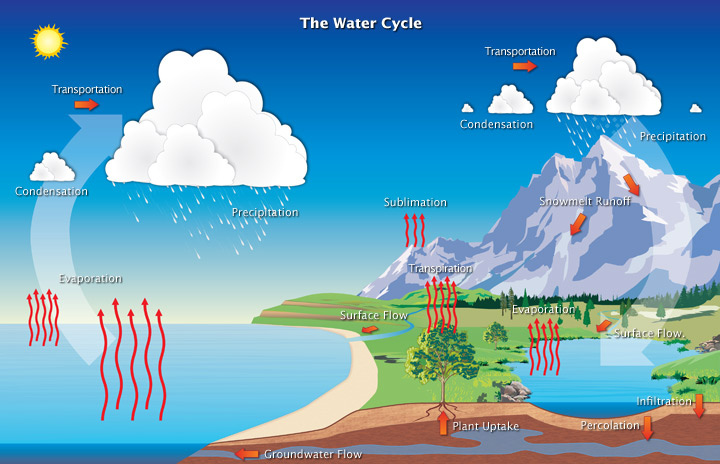Water and sustainability

'The water cycle'. Image is in the public domain
The hydrological cycle is essential to our understanding of the availability and sustainability of freshwater supplies worldwide. An understanding of this cycle includes recognition of the concept of catchment management (Mulligan 2015) and this is a major advance in recognising the importance of ecosystem services as a provider of freshwater systems. Only 2.5% of the planet is covered in freshwater and only 1% is readily accessible (National Geographic 2011).
Essentially, water is required for life on Earth, and so is essential for every ecosystem and its related processes. Yet global water use by human populations relative to accessible supply, has increased by 20% each decade from the 1960s to 2000 (MEA 2005). Demand for freshwater is growing as population grows worldwide, particularly in dryland areas where there is already a deficit of appreciable sustainable water supplies. In 2005 the Millennium Ecosystem Assessment estimated that 1 billion persons worldwide lived in areas of increasing water deficit. The Millennium Ecosystem Assessment (MEA) (2005) identified freshwater as being one of the primary provisions provided by ecosystem services globally. As such, access to freshwater is considered to be a primary constituent of human well-being and so its scarcity represents a threat to the future success of human populations. Primarily, such freshwater resources are needed for agriculture – i.e. 70% of water use worldwide (ibid).
Wherever they are, people need water to survive. Not only is the human body 60 percent water, the resource is also essential for producing food, clothing, and computers, moving our waste stream, and keeping us and the environment healthy…Unfortunately, humans have proved to be inefficient water users (the average hamburger takes 2,400 litres, or 630 gallons, of water to produce, and many water-intensive crops, such as cotton, are grown in arid regions).
(National Geographic 2011: n/p)
Since the 1990s fears globally have been expressed about the likelihood of future wars over water, not just fossil fuels (Elliot 2013; Mulligan 2015). Pollution, agricultural run-off, and over-use have caused problems in both the marine and freshwater environment. The marine water environment has been subject to its own pressures from over exploitation, pollution and global warming in particular. Ultimately, the sustainability of the water resources on the planet are under threat from growing human populations worldwide.